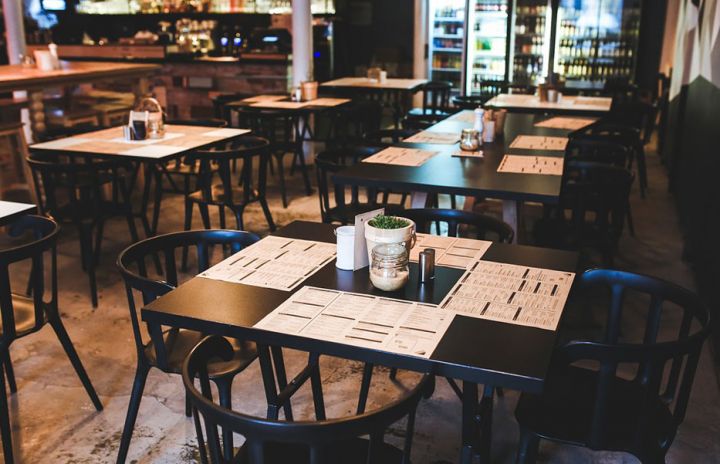We also recommend you check out our complete guide to Buying Commercial Catering Equipment.
How To Plan A Cost Effective & Successful Restaurant Menu

This is the bit you’ve been looking forward to. It’s perhaps the MOST exciting part of starting your catering venture, and it’s one of the most important things to get right. It’s time to plan the perfect menu!
There’s so much to think about when it comes to creating your dream menu. Whether you’re producing a menu from scratch or reinventing an existing one, it is essential to strategically plan what you’re going to offer.
The list determines what ingredients need to be sourced, the costs involved, and the staff and equipment required to bring your menu to life.
Here are some key areas to think about to get started.
Restaurant Menu Design
We’re talking theme, colour and layout. There’s lots of research out there to do with the psychology of how people look at menus.
Some studies say that the top right-hand corner is where customer's eyes are drawn to, while others suggest that we read menus just like a book.
The back page is often overlooked altogether; make sure you reserve this for less profitable dishes such as the kid’s menu or side dishes. Your layout needs to be logical and easy for customers to find what they want.
The use of colour is also said to have a psychological effect on customers and can be used to promote the mood of your restaurant, such as using warm colours for a Mexican theme.
Know The Costs of Your Dishes and Plan Cost Effective Menu Items
It’s a good idea to work out how much each dish will cost to make. That way, you know exactly what your profit margins are.
Investigate your supplier options for all your ingredients so you can compare prices and quality.
Make Your Restaurant Menu Easy to Follow
Think simple but memorable. Research has found that when choosing what to eat, customers prefer to make a decision within two minutes. It is best not to overcomplicate your menu and try to keep it to under 32 items.
Remember, your kitchen team need to be able to handle preparing each menu item and you'll need to stock ingredients and maintain kitchen equipment to prepare each meal. Think about how you can leverage similarities in ingredients and preparation requirements to make your menu cost effective.
Your menu should be easy for customers to read and not contain too much culinary jargon. Present menu options in a way that your intended customer will understand.
Once you’ve got your customers attention on the menu, you need to do your best to sell that dish to them. Come up with the most delicious sounding description you can, thinking about colour, texture, taste, and smell.
When it comes to photos, use them sparingly or use illustrations instead. For most restaurants, we'd recommend not using images at all.
Compare Your Competitor's Menu and Stand Out
Take some time to check out the competition. Find out what they are offering – look at their theme, cuisine and prices, and spot opportunities to provide something they don't. It’s important to keep your menu fresh, relevant and profitable.
Analyse your own menu, and what your competitors are doing at least every 6- 12 months to examine what’s working and what isn’t.
Use Your Menu to Determine What Kitchen Equipment You Need
The more extensive and varied your menu is, the more equipment you will need to accommodate in your kitchen. It’s worth keeping this in mind when thinking about your budget.
What is your restaurant is going to be known for?
The type of cuisine your venue serves will affect what equipment you require. A Thai restaurant sautés a lot of dishes so will need large burner stoves, while a BBQ eatery will need a good-sized grill.
Every meal on your menu will have a list of essential equipment needed to create it. It’s worth taking the time to plan this out as you design your menu. Your menu can help you determine what catering equipment you need to buy, and help you prioritise equipment when budgets get tight.
There is no point putting dishes on your menu if the kitchen can’t comfortably and profitably produce them.
Work Together With Your Chef
Your chef is going to have preferences and can hugely influence your menu design.
It only takes one complicated dish to add a whole new list of expensive equipment to your shopping list.
Make sure you have the appropriate budget for your menu. Consult with your chef and gain their insight into what that dish requires to make it perfect. A good chef knows how to maximise ingredients, equipment, and budget to create profitable menu items for your restaurant.
Your chef will also have their own preferences. One chef might lean towards an old model of stove while another prefers the latest technology. When designing your menu, maintain a clear line of communication and ask your chef their preferences and evaluate how that impacts your equipment budget.
Work with Your Restaurant Equipment Supplier
When you have your menu worked out, you can show this to your catering equipment supplier. Your supplier should know exactly what equipment your kitchen needs, and the most efficient way to set it up.
They should have experience setting up various styles of restaurants, cafes and bars, and be able to provide ongoing support to your business.
© 2021 Dynamic Catering Solutions
